You're likely one of the over 10 million tourists who visit South Africa each year, and as you plan your trip, you're probably wondering when the best time to visit is. The answer isn't as straightforward as you might think, as it largely depends on your preferences and what you have planned. If you're interested in wildlife viewing, the dry winter season might be ideal, but if surfing is more your thing, you'll want to head there during the summer months. As you weigh your options, consider this: the wrong time of year could make or break your trip – so what's the right time for you?
Contents
Key Takeaways
- The dry winter season (May to September) is ideal for spotting wildlife and witnessing the Great Migration.
- Spring (September to November) and autumn (March to May) are perfect for hiking and outdoor activities.
- Summer months (December to February) offer the best surf conditions and warm weather.
- Regional climate variations in South Africa impact the best time to visit different areas.
- The dry season (June to August) is ideal for outdoor activities like safari adventures, hiking, and mountain biking.
Best Time for Wildlife Viewing
When planning your South African adventure, timing is everything, especially if you're an avid wildlife enthusiast.
The country's diverse climate and seasonal patterns significantly impact the best time for wildlife viewing.
From May to September, the dry winter season offers ideal conditions for spotting animals, as they congregate around water sources.
This period is perfect for witnessing wildlife migrations, particularly the Great Migration of wildebeest, zebras, and antelopes.
During this time, the dry vegetation makes it easier to spot animals, and the cooler weather creates a more comfortable viewing experience.
Additionally, the dry season increases the chances of predator sightings, as lions, leopards, and cheetahs are more active in pursuit of prey.
If you're interested in witnessing the dramatic predator-prey interactions, plan your visit during the dry winter months.
The combination of favorable weather conditions and animal behavior makes this period the best time for wildlife viewing in South Africa.
With careful planning, you'll be rewarded with unforgettable wildlife experiences and spectacular predator sightings.
Summer Season in South Africa
Most of South Africa's summer season falls within the months of December to February, a time when the country's diverse landscapes are in full bloom. As you plan your trip to South Africa, expect long days filled with plenty of sunshine and the perfect summer vibes. However, be prepared for heat waves, especially in the northern regions.
| Month | Average High Temperature | Activities |
|---|---|---|
| December | 28°C (82°F) | Enjoy outdoor festivals and events, hike in the Western Cape |
| January | 30°C (86°F) | Explore the beautiful beaches along the Garden Route, go surfing or snorkeling |
| February | 28°C (82°F) | Take a safari adventure in Kruger National Park, visit the vibrant city of Cape Town |
| March | 25°C (77°F) | Attend the Cape Town International Jazz Festival, go whale watching in Hermanus |
During the summer season, the days are long, and the temperatures are warm, making it ideal for outdoor activities. While the heat waves can be intense, the scenic landscapes and exciting events make it a great time to visit South Africa.
Regional Climate Variations Explained
As you explore South Africa's diverse regions, you'll notice that the climate varies significantly from the coast to the interior.
You'll find that coastal areas tend to have a milder climate, with ocean breezes moderating temperatures, while inland regions experience more extreme temperature fluctuations.
When traveling through South Africa, understanding these regional climate variations will help you prepare for the unique conditions you'll encounter along the way.
Coastal Climate Variations
Two distinct coastal climate zones exist in South Africa: the Mediterranean climate along the southwestern coast and the subtropical climate along the southeastern coast.
When you visit the southwestern coast, you'll experience a Mediterranean climate characterized by warm, dry summers and mild, wet winters. This region is influenced by the cold Benguela Current, which brings cooling coastal winds that moderate the temperature.
The southeastern coast, on the other hand, has a subtropical climate with warm, humid summers and mild winters. The warm Agulhas Current dominates this region, bringing warm ocean currents that maintain a relatively stable temperature.
The coastal winds and ocean currents play a significant role in shaping the climate of these regions.
The strong coastal winds along the southwestern coast can make the area feel cooler than the actual temperature, while the warm ocean currents along the southeastern coast maintain a pleasant temperature.
Understanding these coastal climate variations will help you plan your trip to South Africa and make the most of your visit.
Inland Temperature Differences
One of the notable aspects of South Africa's climate is the dramatic temperature difference between its coastal regions and inland areas.
As you travel inland, you'll notice significant variations in temperature, particularly in the Highveld and Lowveld regions.
The Highveld, which includes cities like Johannesburg and Pretoria, experiences a semi-arid climate with cold winters and mild summers.
Highveld temperatures can drop significantly at night, even during the summer months, so be prepared for chilly evenings.
In contrast, the Lowveld region, which borders Mozambique, has a subtropical climate with high humidity levels throughout the year.
Lowveld humidity is particularly noticeable during the summer months, making it feel hotter than the actual temperature.
The region's unique geography, with its escarpments and valleys, creates a microclimate that traps heat and moisture.
This variation in climate is essential to consider when planning your trip to South Africa, as it will impact your choice of clothing, activities, and overall experience.
Understanding these regional differences will help you prepare for the unique conditions you'll encounter in each area.
Best Surfing Spots and Times
Diving into South Africa's vibrant surf culture, you'll find a diverse coastline that's tailor-made for riding the waves.
With over 2,500 kilometers of coastline, you'll have access to some of the world's best surf spots. The best time to surf in South Africa depends on your skill level and the location.
Beginners can head to surf schools in Jeffreys Bay, known for its gentle waves and warm waters, or Muizenberg in Cape Town, which offers a variety of waves for all levels.
For experienced surfers, spots like Dungeons, near Hout Bay, and Supertubes in Jeffreys Bay offer powerful waves that are perfect for surf competitions.
In fact, Jeffreys Bay hosts the annual Billabong Pro surf competition, which attracts surfers from around the world. The best time to catch these waves is during the summer months, from December to February, when the winds are light and the waves are consistent.
Whether you're a beginner or an experienced surfer, South Africa's coastline has something to offer, making it the perfect destination for your next surf adventure.
Winter Months in South Africa
When you visit South Africa during the winter months, from June to August, you can expect crisp, cool weather with average temperatures ranging from 10°C to 18°C.
This dry season brings clear skies and low humidity, making it an ideal time for outdoor activities like hiking, game drives, and exploring the beautiful landscapes.
As you plan your trip, you'll find plenty of exciting dry season activities to enjoy, from whale watching to wine tastings.
Weather and Climate
South Africa's winter months, typically spanning from June to August, bring a welcome respite from the sweltering heat of the summer sun.
During this time, you can expect mild temperatures, averaging around 10-15°C (50-59°F) in the mornings and evenings, while daytime temperatures can reach up to 20-25°C (68-77°F). These temperatures make it ideal for exploring the country's great outdoors.
South Africa's climate varies across different regions, with multiple climate zones influencing the weather patterns.
The western coastal region is generally cooler and wetter, while the eastern coastal region is warmer and more humid. Inland areas tend to be drier, with lower humidity levels. The country's diverse geography also gives rise to microclimates, with some regions experiencing unique weather conditions.
As you plan your trip, consider the regional climate variations and pack accordingly.
Be prepared for potential cold fronts and rain showers in the western regions, while the eastern regions may experience milder winters. Understanding South Africa's climate zones and humidity levels will help you make the most of your winter visit.
Dry Season Activities
Three of the best months to experience the great outdoors in South Africa are June, July, and August.
These winter months bring dry and cooler weather, making them ideal for exciting outdoor activities. You'll find that the dry season is perfect for safari adventures, as the clear skies and sparse vegetation allow for better animal sightings.
Imagine going on a guided tour, witnessing majestic lions and elephants in their natural habitats.
During these months, you can also enjoy the night sky like never before.
With minimal cloud cover, the stargazing nights are simply breathtaking. Lie down on a blanket, gazing up at the stars twinkling above, and feel a deep connection to the universe.
The dry season is also great for hiking and mountain biking, with cooler temperatures and dry trails making for more enjoyable excursions.
Make the most of your trip to South Africa by taking advantage of the dry season's many activities.
Whether you're an adventure-seeker or nature lover, June, July, and August offer the perfect conditions to create unforgettable memories.
Best Time for Hiking and Outdoor
How do you plan to make the most of your outdoor adventure in South Africa? If hiking is on your agenda, you'll want to time your visit carefully.
The best time for hiking and outdoor activities in South Africa is during the spring (September to November) and autumn (March to May) seasons. These periods offer mild temperatures, fewer crowds, and scenic landscapes.
During these seasons, the mountain trails are particularly stunning, with vibrant wildflowers blooming in the spring and comfortable temperatures in the autumn.
The scenic beauty of South Africa's nature escapes is on full display, making it an ideal time for hiking and outdoor exploration. The cooler weather also makes it easier to tackle challenging trails, such as those in the Drakensberg and Cederberg mountains.
Whether you're a seasoned hiker or just looking for a leisurely stroll, the spring and autumn seasons are perfect for exploring South Africa's great outdoors.
Regional Events and Festivals
After immersing yourself in the breathtaking natural beauty of South Africa's great outdoors, you'll want to experience the country's vibrant culture by attending one of its many regional events and festivals.
From Cape festivals to Winelands celebrations, there's always something happening in South Africa. In the Western Cape, you can enjoy the Cape Town International Jazz Festival, which showcases local and international jazz talent.
The Cape Winelands are also home to various wine festivals throughout the year, where you can sample some of the region's renowned wines.
In the Eastern Cape, the Grahamstown National Arts Festival is a must-attend event, featuring a diverse program of music, theater, and dance performances.
If you're visiting KwaZulu-Natal, don't miss the Durban July, a prestigious horse racing event that's also a major social occasion.
The country's rich cultural heritage is also celebrated at various festivals, such as the Zulu Reed Dance Festival and the Cape Town Minstrel Carnival.
With so many exciting regional events and festivals to choose from, you're sure to find something that suits your interests and enhances your South African experience. Each event offers a unique glimpse into the country's rich cultural tapestry.
Weather Patterns by Region
South Africa's diverse geography, stretching from the Atlantic to the Indian Ocean, creates varied regional weather patterns that you'll want to consider when planning your trip. The country's climate is influenced by its unique geography, resulting in diverse weather conditions across different regions.
| Region | Summer (Dec-Feb) | Winter (Jun-Aug) |
|---|---|---|
| Western Cape | Hot and dry | Cool and wet |
| Eastern Cape | Warm and humid | Cool and dry |
| KwaZulu-Natal | Hot and humid | Mild and wet |
| Gauteng | Hot and dry | Cool and dry |
When traveling to South Africa, you can expect distinct rainfall patterns and weather extremes across the country. The Western Cape is known for its Mediterranean climate, with hot and dry summers, while the Eastern Cape experiences a more humid climate. KwaZulu-Natal's subtropical climate brings hot and humid summers, with mild winters. Gauteng's dry climate makes it an ideal destination for those who prefer less humidity. Understanding these regional weather patterns will help you plan your trip accordingly and make the most of your time in South Africa.
Conclusion
As you plan your trip to South Africa, remember, "variety is the spice of life." With diverse climates and activities to suit every taste, you're sure to find the perfect time to visit. Whether it's wildlife viewing, surfing, or hiking, each season has its perks. Consider your interests and the region you'll be visiting to make the most of your trip. A little planning will go a long way in making your South African adventure unforgettable.









